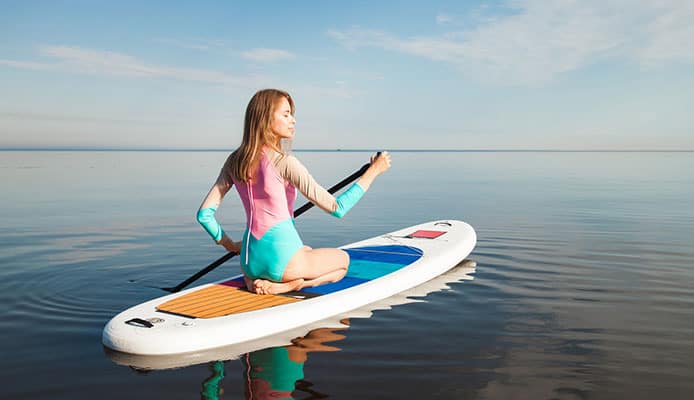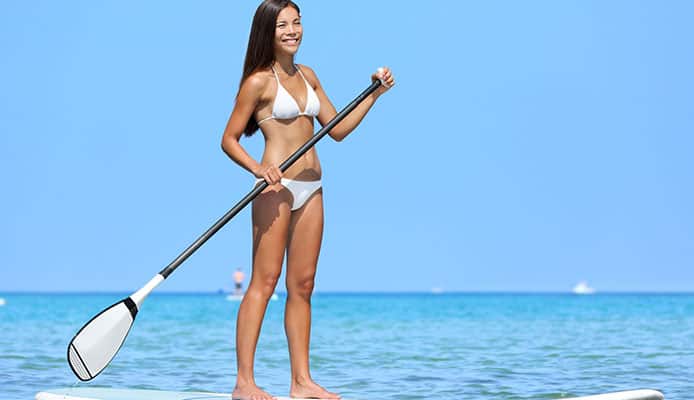
Paddleboarding is a fun activity that gets you to enjoy the beautiful water world. It is one of the simplest ways to explore the marine environment and tone your muscles. You can do just about anything on a paddleboard – fishing, surfing, and even some butt-kicking SUP yoga poses.
But you will only enjoy paddleboarding if you invest in the right board for your weight. In other words, you will need something that provides enough stability and floatation for your specific body weight, height, and paddling skills.
To determine the right paddleboard sizing, you need to focus particularly on the board’s volume, length, width, and thickness. But selecting a paddleboard can be a little overwhelming. So here is a quick guide on how to choose the right paddle board size that will make your work a lot easier.
Your Weight
A paddleboard is supposed to carry your weight, so make sure it can. Many paddleboard manufacturers today have started including a paddleboard size chart in the user manual to indicate the maximum weight that the board can hold.
If a board cannot support your weight, it will feel unstable, ride too low on the water, or even worse, sink underneath you. Therefore, checking the maximum weight capacity will help you determine whether a board is appropriate for you or not.
A paddleboard that supports surplus weight will generally make your experience more enjoyable and could also allow you to bring someone along for the adventure. Maybe you want to take your kids or spouse out on a water trip. Perhaps you want to teach your dog how to paddleboard or just need something that can carry extra fishing or paddling gear. Selecting a board that holds the extra weight perfectly will keep you more stable, buoyant, and safe while on the water.
Kind Of Paddleboarding
Think carefully about the kind of paddleboarding you intend to do. For surfing, you will want to go for a shorter board with a narrower tail and nose section.
Want to try yoga? Get a wide board. The best yoga paddleboard will be somewhere between 31 and 33 inches.
How about touring/racing? You will need a board that maintains its course and one that has less drag. A good touring/racing paddleboard will be long and narrow, probably about 12 feet long.
If you are looking for a board for your kids, consider something below 10 feet. Most kids’ paddleboards are typically around 8 feet and will maneuver more easily than longer boards.
For beginners, all-around paddleboards will be the best option. Most of these boards are usually between 9 and 11 feet long and about 30 or 32 inches wide. They are designed with a rounded tail and nose section, have a greater volume, and are more stable than surf paddleboards.
Knowing what you intend to do with your paddleboard beforehand will help you invest in the right size and will undoubtedly make your adventures safer and more comfortable.
Your Height
Did you know that your height also plays a huge role when it comes to determining the right paddleboard sizing? That’s right! Shorter people will have a lower point of gravity than taller people so when riding a paddleboard, a taller person will find it more difficult to maintain its balance than a shorter person.
You might also like: Learn To Teach Your Dog To Paddle Board
When choosing a paddleboard, try to match its width to your height. Generally, if you are taller, go for a wider board and if you are shorter, get a narrower one. A shorter person will find their balance with ease on the narrow board while a taller person will struggle to do so.
Also, if a smaller person uses a board that is too big for them, they will have to stretch their arms to the side to get their paddle striking the water. This could result in improper strokes and the paddler may not be able to reap the benefits of paddleboarding.
Board’s Thickness
Once you have found a board with the perfect length and width, check its thickness. Thickness affects the board’s overall weight capacity and volume.
Pick two boards of the same measurements (length and width) but a different thickness, for instance. You will notice that the thinner board has a lower volume than the thicker one. Now, the more the volume of your board, the more load it can carry.
If you will be going on a long trip and need to bring extra equipment like lunch coolers, water bottles, or tackle boxes with you, a thicker paddleboard will be your best bet. This will perfectly hold the extra weight and remain stable throughout your trip. Just remember to read the paddleboard size chart before making your purchase to be sure that the board can actually carry the weight of your gear without sinking.
Paddle Board Fins
Sometimes paddleboards come with fins. Some come with one while others come with up to four, usually in varying sizes. The purpose of fins is to add stability and tracking to the board.
The longer and wider the bases of the fins are, the more stable and straighter your board will be. Some paddleboarders prefer smaller or fewer fins because they are maneuverable. But fins are removable. You can actually swap them or install the number you want for your specific paddleboarding needs.
Board’s Construct
Paddleboards come as either solids or inflatables. While solid boards are more durable, inflatable paddle boards, save on space. When thinking about the size of the board you want to invest in, whether to go for a solid or inflatable construct is a decision you need to make carefully, especially if you don’t have enough storage space.
If you live in an apartment, condo, or small house, chances are good you don’t have room for a giant solid board. An inflatable will be compact when deflated and will easily fit in a small space, like the trunk of your car or in a closet. Even under the bed!
Globo Surf Overview
Paddleboarding allows you to enjoy the great marine environment. It is also a great way to tone your muscles and keep fit.
However, the secret to an enjoyable paddleboarding adventure is obtaining a good-sized board. The rule of thumb here is to invest in a board that can support your weight perfectly and keeps you stable. There are different paddleboard designs and sizes for different activities, so think about what you intend to use your board for before making a purchase.
Skills Paddle Board Guides:
- SUP Deck Rigging Guide
- How To Convert A SUP Into A Kayak
- How to Transport Your Stand Up Paddle Board
- A Beginners Guide To SUP Surfing
- Make Your Own SUP Paddle
- SUP Fitness: How Many Calories Does Paddle Boarding Burn?
- SUP Training Exercises
- Falling Off and Getting Back Up On Your SUP: It Happens To The Best Of Us
Source


